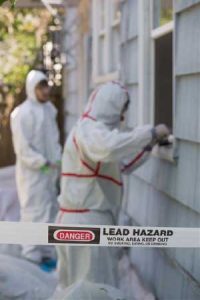 Workers involved in the renovation, repair, tear down, and disposal of damaged or destroyed structures and materials can encounter materials that contain lead. Repair, renovation, and demolition operations often generate dangerous airborne concentrations of lead, which is a metal that can cause damage to the nervous system, kidneys, blood forming organs and reproductive system, if inhaled or ingested in a dangerous quantity. The Occupational Safety and Health Administration (OSHA) has developed regulations designed to protect workers during activities that might include lead exposure.
Workers involved in the renovation, repair, tear down, and disposal of damaged or destroyed structures and materials can encounter materials that contain lead. Repair, renovation, and demolition operations often generate dangerous airborne concentrations of lead, which is a metal that can cause damage to the nervous system, kidneys, blood forming organs and reproductive system, if inhaled or ingested in a dangerous quantity. The Occupational Safety and Health Administration (OSHA) has developed regulations designed to protect workers during activities that might include lead exposure.
Lead Exposure Can Occur by:
Lead-based paints, lead solder, electrical fillings and conduits, tank linings, plumbing fixtures, and many metal alloys; and
Operations that generate lead dust and fumes, including demolition of structures, flame torch cutting, welding, use of heat guns, sanders, scrapers, or grinders to remove lead paint, and abrasive blasting of steel structures.
OSHA’s Lead Standard Highlights:
OSHA has established a permissible exposure limit (PEL) of 50 micrograms of lead per cubic meter of air, as averaged over an 8-hour timeframe.
- A doctor should see adults with levels of lead in their blood above 30ug/dL. Some harmful effects of lead are permanent.
- Employers should test workplace air for lead and blood lead levels in workers.
- Employers should tell workers if their work involves lead and train workers on lead safety.
- Employers should give workers a place to wash hands and take a shower.
- Employers are required to use engineering controls and work practices, where feasible, to reduce worker exposure.
- Employers should provide workers a place to change into clean clothes. Keep work clothes away from street clothes.
- Employees are required to observe and practice good personal hygiene, such as washing hands often, especially before eating and taking a shower at the end of a work shift, before leaving the work site.
- Employees should change out of work clothes and shoes before going home.
- Employees should not take contaminated work clothing or shoes exposed to lead home. If you must, put them in a plastic bag and wash your work clothes separately.
- Employees are required to be provided with protective clothing and, where necessary, with respiratory protection in accordance with 29 CFR 1910.134.
- Employees exposed to high levels of lead are required to enroll in a medical surveillance program.
- Employees should tell their doctors that they work with lead.
Sources references include Title 29 Code of Federal Regulations (CFR), Part 1926.62., OSHA Quick Card and OSHA Fact Sheet
LEAD IT BE, LEAD IT BE…DANGEROUS TO YOU AND ME!
Download flyer: STOTW_1040_Lead_Hazards Download Spanish flyer: STOTW_1040_Lead_Hazards _esp

